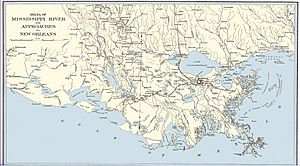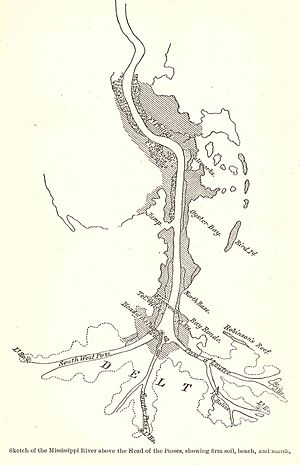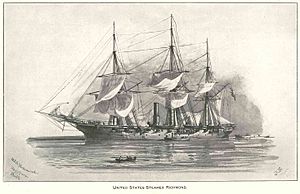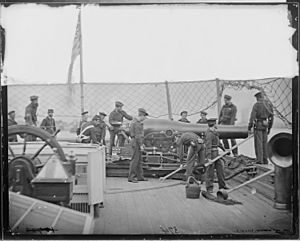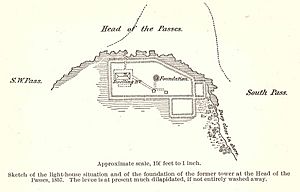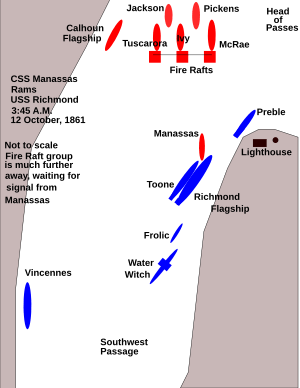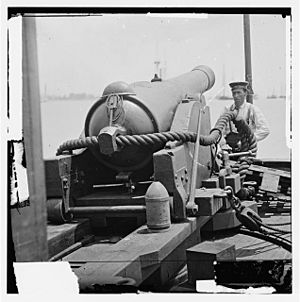Battle of the Head of Passes facts for kids
Quick facts for kids Battle of the Head of Passes |
|||||||
|---|---|---|---|---|---|---|---|
 |
|||||||
|
|||||||
| Belligerents | |||||||
| Commanders and leaders | |||||||
| Strength | |||||||
| 3 sloops-of-war 1 schooner 1 gunboat |
1 ironclad 6 gunboats 3 fire rafts |
||||||
| Casualties and losses | |||||||
| none 2 sloops-of-war damaged 1 schooner damaged |
none 1 ironclad damaged |
||||||
The Battle of the Head of Passes was a naval battle during the American Civil War. It happened on October 12, 1861, at the Head of Passes in the Mississippi River Delta. This battle was unique because no one died. It was a surprise attack by the Confederate "mosquito fleet" on Union ships.
The Confederate fleet used a special ship called the CSS Manassas, which was an early ironclad. They also used three "fire rafts" to scare the Union ships. The attack happened before sunrise and made the Union fleet retreat in a hurry. Later that morning, the Confederate ships pulled back because they were running low on supplies.
Contents
Why the Battle Happened: The Blockade Begins
The state of Louisiana left the Union in January 1861. The new Confederate government quickly set up a navy department. Their goal was to defend important cities like New Orleans. This city was the largest in the Confederacy.
The Union, on the other hand, had a clear plan. President Abraham Lincoln announced a naval blockade in April 1861. This meant Union ships would block Confederate ports. The goal was to stop supplies from reaching the Confederacy. Union ships quickly arrived at the mouth of the Mississippi River. This surprised everyone in New Orleans.
The Confederate Navy faced many problems. They struggled to get enough ships. Many ships were bought by private citizens to become "privateers." These privateers could capture Union ships for profit. This made it hard for the navy to build its own fleet.
Commodore George N. Hollins took charge of the Confederate fleet in New Orleans. He gathered six small riverboats. These were lightly armed and known as the "mosquito fleet." The Confederates also planned to build large ironclad ships, but these would not be ready until 1862.
Union Strategy at the Head of Passes
The Union Navy wanted to control the Head of Passes. This area was where the Mississippi River split into several channels leading to the sea. By controlling it, they could block all sea access to New Orleans. This would also make it easier to attack Fort Jackson and Fort St. Philip. These forts were the last defense for the city.
On October 10, 1861, Union Captain William W. McKean ordered four ships to the Head of Passes. This move was a big threat to New Orleans.
Confederate Response: The Manassas Joins the Fleet
Commodore Hollins knew he had to act. He moved his "mosquito fleet" south to Fort Jackson. There, he took control of a privateer ironclad ram called the Manassas. This ship was taken by force for the Confederate Navy.
The Manassas was the first ironclad of the Civil War to enter battle. It was a very new and scary type of warship. With the Manassas, Hollins felt his small fleet had a chance. Even against the much larger Union ships.
The Battle Unfolds: A Surprise Attack
Hollins decided to attack the Union fleet before dawn on October 12. He wanted to use the darkness to his advantage.
Union Ships at the Ready
The main Union ship at the Head of Passes was the USS Richmond. This was a powerful wooden steamship. It had many large guns. The Richmond was much bigger than any Confederate ship. It had a crew of 260 trained sailors.
Supporting the Richmond were the Vincennes and Preble. These were sailing ships with many guns. The Water Witch, a steam-powered gunboat, was also there. It could help tow the sailing ships if needed.
Captain Pope's Concerns
The Union commander, Captain John Pope, was worried. He was the captain of the Richmond. He was concerned about the Confederate gunboat CSS Ivy. The Ivy had a rifled gun that could shoot farther than his own smoothbore guns. Pope felt his position was unsafe. He did not set up good defenses, like guard boats or marker buoys.
Hollins' Bold Plan
Hollins' plan was daring. The Manassas would lead the attack. It would try to ram and crush the USS Richmond. Following the Manassas would be other Confederate gunboats. Each gunboat would push a fire raft. These rafts would be set on fire after the Manassas hit the Richmond. The burning rafts would then float towards the Union fleet. This would cause chaos and make the Union ships easy targets.
The Attack Begins
The Preble spotted the Manassas first. It fired a warning shot and raised a signal light. The Manassas was hard to hit because only a small part of it was above the water. It sped towards the Richmond.
The Manassas hit the Richmond on its side. The impact tore a coal schooner, the Joseph H. Toone, away from the Richmond. The Manassas then lost power because one of its engines was damaged. It slowly moved back upriver.
Union Retreat and Confederate Withdrawal
The Manassas fired three rockets as a signal. This caused the Union ships to panic. They quickly pulled up their anchors and moved downriver. They fired at the Manassas as they left. One of the Manassas' smokestacks was hit, filling the ship with smoke. The Manassas then ran aground on the mud.
The Confederate gunboats chased the Union fleet. The fire rafts also ran aground. The Richmond got stuck in the mud too. The Confederate ships fired at the Richmond from a distance. They used their longer-range rifled guns. The Richmond was hit twice, but not badly damaged.
By 10:00 AM, the Confederate fleet was running low on coal and ammunition. Hollins ordered his ships to return to Fort Jackson. The damaged Manassas was towed back.
In a strange event, the captain of the Vincennes misunderstood a signal. He tried to blow up his ship and abandon it. Luckily, his engineer stopped the fuse. The captain and crew were ordered back to their ship.
Aftermath: A Confederate Victory, A Union Embarrassment
Commodore Hollins was celebrated as a hero in New Orleans. Newspapers praised the "mosquito fleet." People were amazed that a small Confederate force could scare away a stronger Union fleet.
However, the battle did not change much. The Union ships were only temporarily driven away. The Confederates captured a small boat and the coal schooner Toone. The Manassas was the most damaged ship. Its ramming attack caused a leak in the Richmond, but it was not enough to sink it.
The Impact of the Manassas
The Manassas did not perform as well as hoped. It was too slow to use its ram effectively. But it had a huge psychological effect on the Union Navy. Sailors became very afraid of the "infernal ram." This fear was called "ram fever."
The Union naval leaders were very upset by this defeat. They called it "Pope's Run." Admiral David Dixon Porter later said it was "the most ridiculous affair that ever took place in the American Navy."
Union Response and Future Plans
The damage to the Union ships was easily fixed. The Union Navy sent more ships to the Mississippi Delta. Flag-Officer David Farragut took command of the new fleet. This stronger force would later lead to the Battle of Forts Jackson and St. Philip. Captain Pope resigned due to "health reasons," and Captain Handy was sent away.


